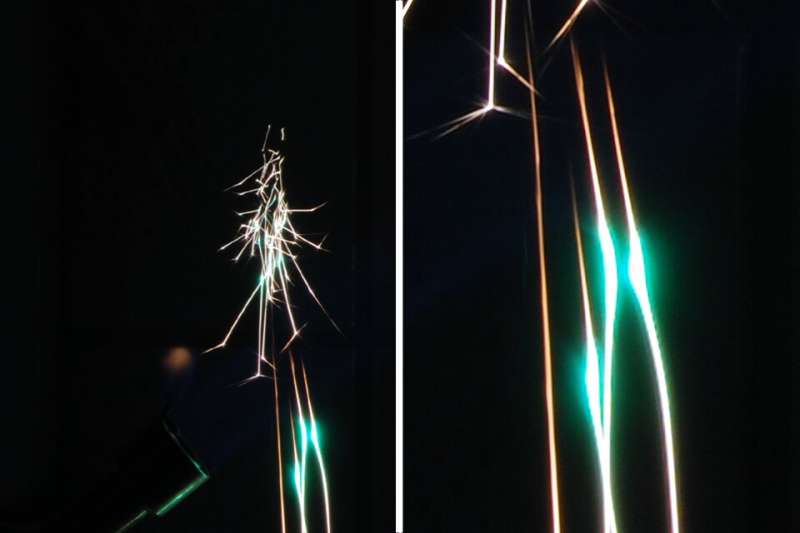Color-changing sparks

Sparks are a fascinating phenomenon well-known from campfires, flint stones and electric sparklers and other pyrotechnic articles. Looking at sparks more closely reveals the limited colors in which they appear. Dark red-orange sparks are known from charcoal, iron powder leads to yellow/golden sparks, and hot burning elemental metal powders such as aluminum and titanium can form bright white sparks.
The color of sparks is dominated by black body radiation. Consequently, the temperature of the spark controls its emitted wavelength. Differently colored sparks, e.g. green, blue, bright red/pink are not possible in the solid state. To achieve sparks in these colors, gas phase combustion is required. In the gas phase, element-specific emission takes place. In principle, the full spectrum of colors could be achieved, as known from the flame colors of various elements. Unfortunately, although few metals that burn in the vapor phase are known, the resulting sparks are very short, thick and the visual appearance is poor. This is readily explained by the fast evaporation of the metal.
Researchers from the Clausthal University of Technology (Germany) headed by Prof. Eike G. Hübner searched for long-burning and intensively colored sparks. After considering the theoretical background, first author Felix Lederle and Eike Hübner found one metal that should form long-burning green sparks: erbium. Using erbium powder of an appropriate grain size around 80 microns unexpectedly led to the first description of color-changing sparks burning in three phases and final branching of the sparks. The findings have recently been published as very important paper and cover feature in the European Journal of Inorganic Chemistry.
The phases of the spark are readily explained by a cooler starting phase, which exhibits black-body emission (orange-white), a very hot phase that leads to vapor-phase combustion and intense green emission of erbium monoxide in the gas phase, and finally a third phase based on black-body emission, again. The different phases of the spark have been analyzed by time-resolved emission spectra in cooperation with the Fraunhofer Heinrich-Hertz-Institute, Goslar (Germany) by co-author Jannis Koch.
Additional experiments were performed with other materials such as tellurium for blue and sodium-soaked silica powder for yellow sparks.
The color changing erbium sparks present a long-flying, bright and intensively colored appearance, and may allow producing sparklers and other pyrotechnic devices in exotic colors. Furthermore, the investigations can be helpful for bright flares and signaling devices.
At the end of their publication, the scientists present the first smokeless indoor fountain based on color-changing erbium sparks and other uncommon compositions, such as a fountain with dark-red sparks based on diamond powder.
More information: Felix Lederle et al. Colored Sparks, European Journal of Inorganic Chemistry (2018). DOI: 10.1002/ejic.201801300
Journal information: European Journal of Inorganic Chemistry
Provided by Clausthal University of Technology




















